Friday, 21 November 2025
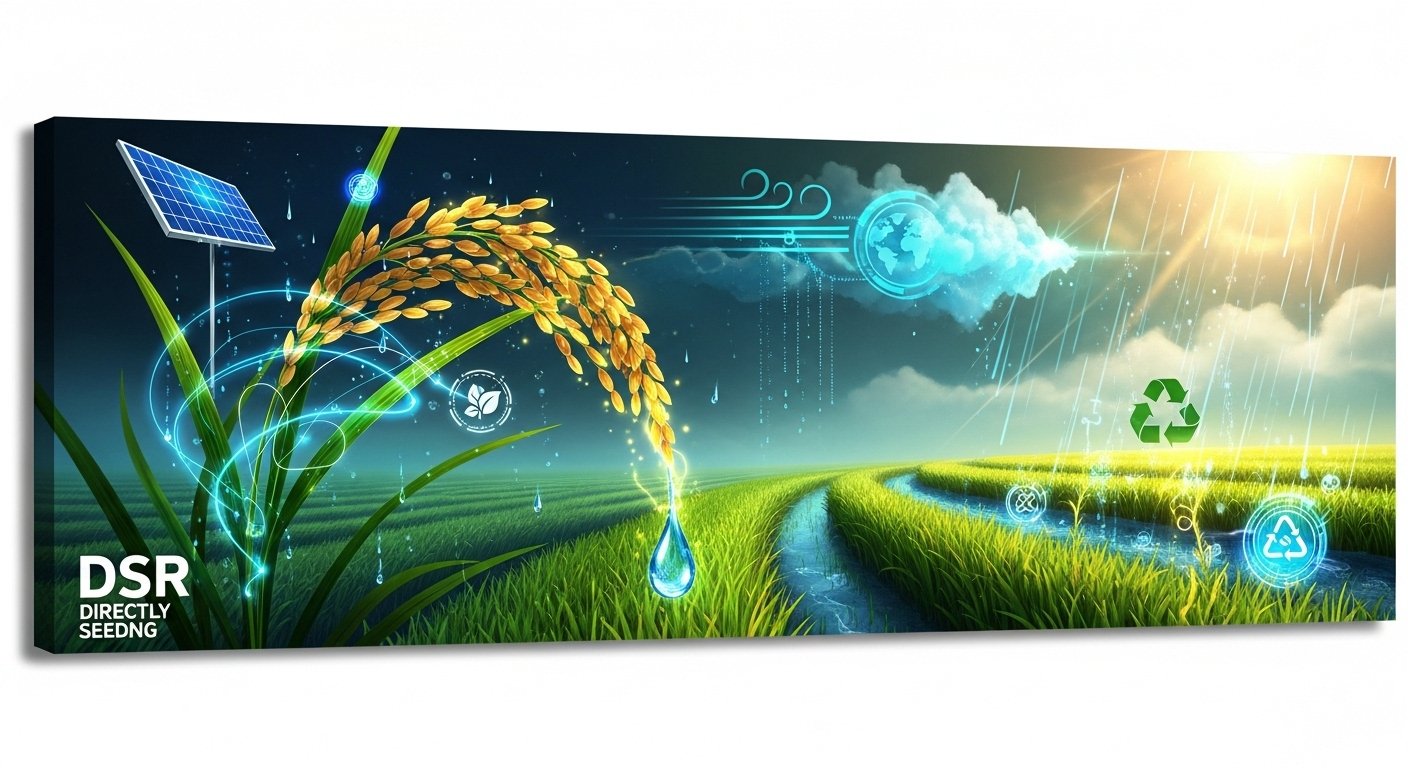
As India grapples with groundwater depletion and climate volatility, Dry Direct Seeded Rice (DSR) emerges not as a technical tweak — but as a potential paradigm shift toward climate-smart, resource-efficient grain production
For over five decades, India’s Green Revolution has rested on the shoulders of rice — the crop that fed the nation, stabilized its politics, and transformed its economy. But the same success story is now under ecological strain.
India produces over 110 million tonnes of rice annually, cultivating nearly 45 million hectares of land. The majority — nearly 80 per cent — is grown through the conventional method of puddled transplanting, where rice seedlings are raised in nurseries, uprooted, and replanted in flooded fields. This process, though time-tested, is increasingly untenable in a climate-constrained world.
Flood irrigation consumes roughly 4,000–5,000 litres of water per kilogram of rice, making it one of the most water-intensive cereals on earth. In Punjab and Haryana — epicentres of India’s rice bowl — groundwater tables are falling by 0.5 to 1 metre annually, threatening the sustainability of entire agro-economies. Meanwhile, methane emissions from flooded paddy fields account for over 17 per cent of India’s agricultural greenhouse gases, compounding global warming.
As labour costs rise and water tables fall, farmers are confronting an uncomfortable truth: the old logic of abundance no longer holds. The need for a climate-resilient alternative has never been sharper — and Dry Direct Seeded Rice (Dry DSR) is emerging as that candidate.
The Science and Promise of Dry DSR
At its essence, Dry Direct Seeded Rice (Dry DSR) signifies not merely a change in agronomic technique but a paradigmatic reimagination of how India cultivates its most politically and ecologically consequential crop. It dispenses with the laborious ritual of transplanting, replacing it with the direct sowing of dry rice seeds through precision drills or zero-till planters. By abolishing the anachronistic choreography of nurseries and puddling — the age-old practice of flooding and ploughing to fashion a pliant seedbed — Dry DSR represents a quiet revolution in the paddy field.
“Redefining Rice Cultivation”*- “KisanKraft is redefining rice cultivation through its Dry Direct Seeded Rice (DDSR) technology. By developing varieties suited for dryland conditions, we are making rice cultivation sustainable, profitable, and future-ready. DDSR offers farmers resilience against water scarcity while protecting the environment.”
—Ravindra Agrawal, Chairman, KisanKraft Limited
Rather than perpetually submerging the crop in water, the system thrives on judicious, intermittent irrigation or on residual soil moisture from pre-monsoon showers. The implications are profound: substantially lower water consumption, sharply reduced energy expenditure, and an agronomy that is congenial to mechanisation — a timely adaptation as the rural labour force diminishes and wage rates ascend.
The empirical evidence is compelling. Multi-location trials by the Indian Council of Agricultural Research (ICAR) and the International Rice Research Institute (IRRI) across Punjab, Telangana, and Odisha demonstrate that Dry DSR can curtail water use by 20–35 per cent, reduce energy costs by 15–25 per cent, and diminish methane emissions by up to 40 per cent — all without compromising yields. Under judicious management, harvests of 5.5–6 tonnes per hectare rival those of conventionally puddled, transplanted rice.
“By eliminating the need for standing water, nursery and transplanting, this technology unlocks the door to full mechanization of rice cultivation. This not only dramatically reduces the overall labor requirement but also significantly alleviates the drudgery, making rice production more appealing, efficient, and profitable for the modern farmer.”
— Amit Sharma, CEO, KisanKraft Limited
Equally transformative are the subterranean benefits. The continuous flooding characteristic of traditional systems, though effective at suppressing weeds, engenders anaerobic conditions that erode soil structure, deplete microbial diversity, and accelerate nutrient loss. Over time, this creates a pernicious dependency on escalating water and energy inputs. In contrast, Dry DSR preserves the soil’s porosity and microbial vibrancy, fostering a living, breathing rhizosphere. Studies at Punjab Agricultural University reveal a 15 per cent enhancement in organic carbon and microbial biomass after three successive DSR cycles compared to their flooded counterparts — a statistic that underscores the system’s ecological sagacity.
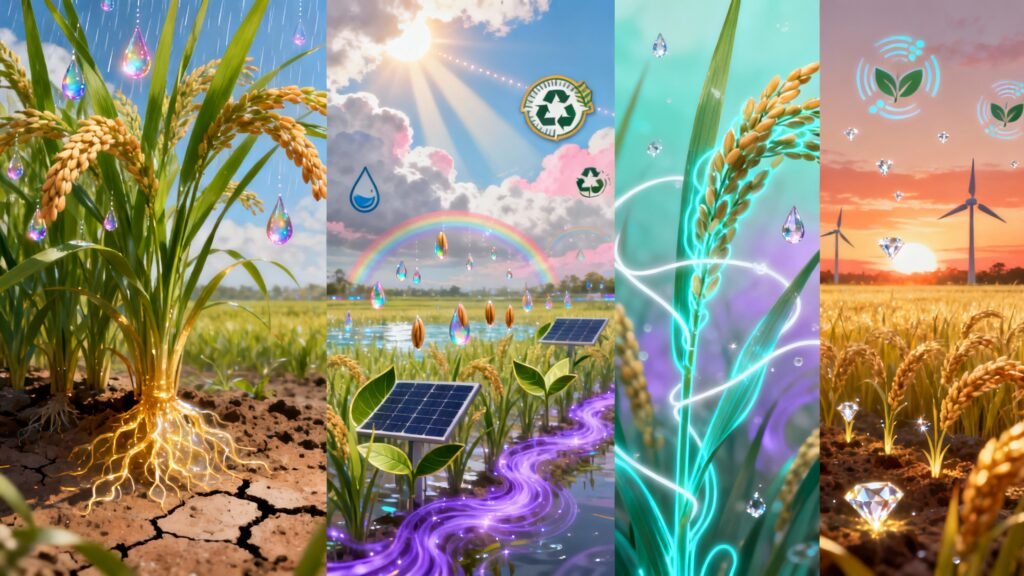
Beyond the soil, time itself becomes a resource regained. By eliminating the transplanting lag, Dry DSR abbreviates the crop duration by 7–10 days, enabling an earlier harvest. In the context of North Western India, where delayed rice harvesting impinges upon wheat sowing, this temporal efficiency carries vast environmental dividends. It allows timely wheat planting, thereby curtailing the pernicious practice of residue burning that envelops northern skies in an annual pall of smoke.
Moisture management, too, becomes a delicate ballet. Successful germination requires that the upper 5–7 centimetres of soil retain consistent moisture during the initial ten days — a feat achieved through two or three measured irrigations rather than indiscriminate flooding. Increasingly, soil moisture sensors and satellite advisories are supplanting intuition, compelling farmers to trust algorithms over appearances — a cultural transition as significant as any technological one.
The rice plant, for its part, adapts admirably. In aerated soils, roots delve deeper and grow more fibrous, enhancing drought resilience and nutrient uptake. Studies from IRRI’s Philippine research farms report 20 per cent higher root biomass and 10–15 per cent greater nitrogen-use efficiency in DSR plants, translating to reduced fertiliser use and lower nitrous oxide emissions. The environmental dividend, thus, multiplies across the production chain.
Crucially, Dry DSR reintroduces agronomic versatility long foreclosed by puddling. Without the waterlogging that suffocates other crops, farmers can reimagine their rotations — rice–lentil–mustard sequences in Madhya Pradesh and eastern Uttar Pradesh are already demonstrating gains in soil nitrogen and diversified incomes.
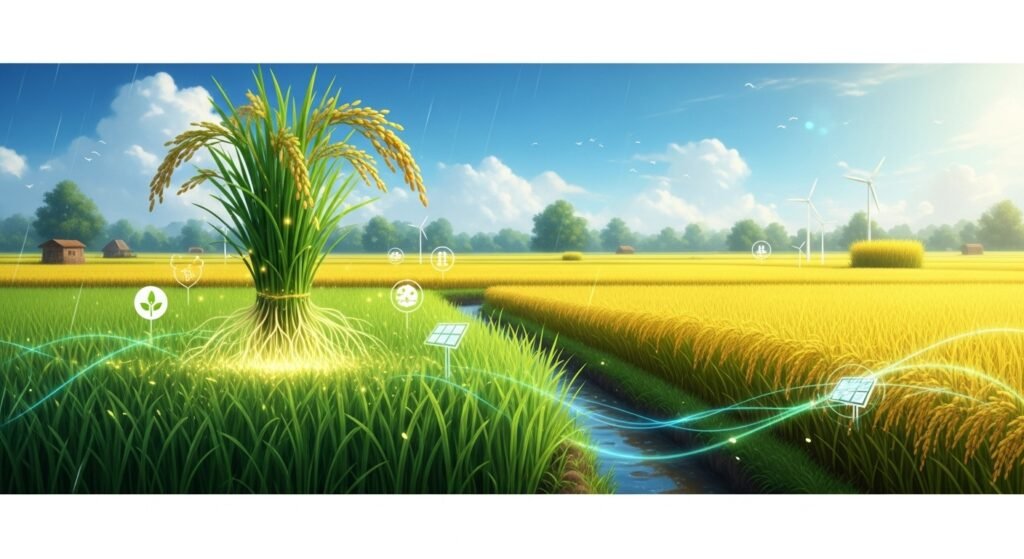
Globally, the winds of change are unmistakable. In Vietnam’s Mekong Delta, where salinity and water scarcity imperil conventional paddy, Dry DSR complements alternate wetting and drying systems to sustain productivity. The Sustainable Rice Platform records reductions of two tonnes of CO₂-equivalent emissions per hectare, with concomitant income increases of 12–15 per cent. Such precedents are now inspiring India’s climate-smart rice pilots under the National Innovations in Climate Resilient Agriculture (NICRA) initiative.
For India, however, Dry DSR is more than a water-saving stratagem; it is a structural redesign of the triad that underpins its food security — water, labour, and energy. It fuses precision agronomy with microbial ecology and digital intelligence, heralding a future where sustainability is not an afterthought but an organising principle.
Still, the fulcrum of this transformation will be institutional trust. Demonstration farms, FPO-led machinery pools, app-based irrigation advisories, and incentive structures for residue management must converge to create an enabling ecosystem. The science of DSR is, by now, incontrovertible. What remains is to build the social and policy architecture that allows millions of farmers to claim it as their own. In that lies not only the promise of a sustainable paddy revolution but perhaps the first glimmer of India’s agrarian renaissance.
The Climate Argument: From Adaptation to Mitigation
Dry DSR is more than a water-saving technique; it represents a climate adaptation strategy for one of the most vulnerable farming systems on earth. As erratic monsoons and heatwaves disrupt sowing windows, the method offers flexibility and resilience.
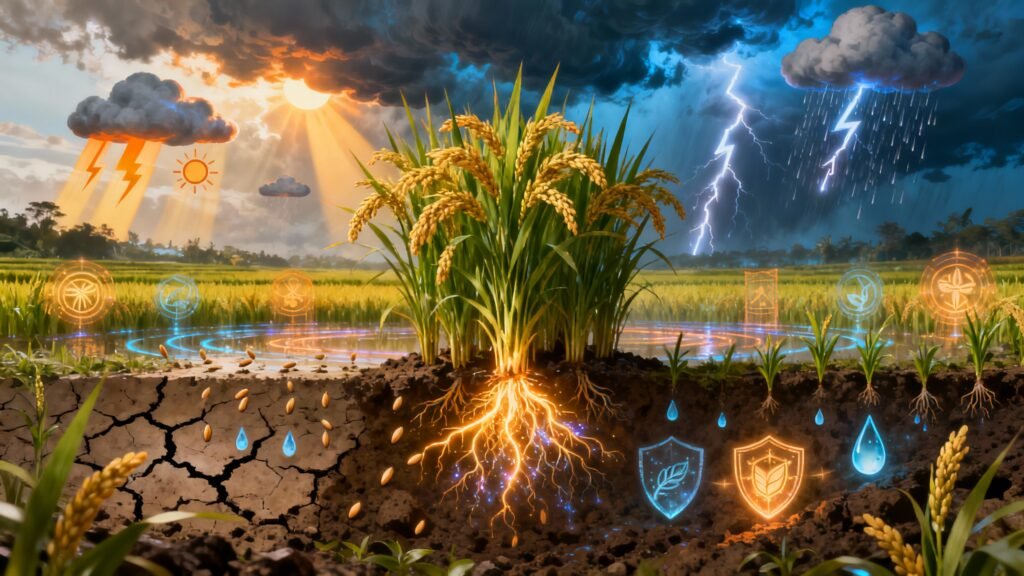
By eliminating the need for standing water, Dry DSR reduces both evaporation losses and methane emissions — a greenhouse gas 28 times more potent than CO₂. According to the National Innovations in Climate Resilient Agriculture (NICRA) programme, large-scale adoption of Dry DSR could cut India’s annual methane emissions by 11–12 million tonnes CO₂ equivalent — roughly the carbon footprint of 3 million passenger vehicles.
Beyond mitigation, the method supports climate adaptation by enabling rice cultivation in regions facing water scarcity. Pilot projects in Chhattisgarh, Odisha, and Telangana show Dry DSR thriving under rainfed conditions where conventional transplanting is infeasible.
In Punjab, the Punjab Agricultural University (PAU) reported that farmers adopting DSR saved an average of 20–25 irrigation events per season, translating to 1,200–1,500 cubic metres of groundwater conserved per hectare. In water-stressed districts like Sangrur and Moga, these savings are not incremental—they’re existential.
The Technology Enabler: Machinery, Microbes, and Moisture Sensors
The success of Dry DSR hinges on a symphony of enablers — from laser land levelling to planter precision, and increasingly, biological and digital interventions.
“DDSR reduces water use by up to 60 per cent, minimizes methane emissions, and lowers input costs without compromising yield. Farmers benefit from higher income and improved soil health. It is a farming system where sustainability meets profitability.”
–— Dr. Sumanth Holla, AGM- Seeds, KisanKraft Limited
First, mechanisation. Happy Seeder-compatible planters, rotary drills, and zero-till seeders are central to ensuring uniform depth and spacing — critical for good germination. Equipment costs, once prohibitive, are now being brought down through FPO-led service models and state subsidies.
Second, soil microbiology. Researchers at IARI and the University of Agricultural Sciences, Dharwad have shown that microbial consortia containing Azospirillum, Pseudomonas, and Trichoderma can enhance seedling vigor and suppress soil-borne pathogens in DSR systems. Similarly, biofertilisers and plant growth-promoting rhizobacteria (PGPR) are being explored to reduce nitrogen loss and improve nutrient uptake.
Third, data and digital tools. IoT-based soil moisture sensors, coupled with smartphone dashboards, now allow farmers to schedule irrigation precisely when soil moisture dips below critical levels — bridging the gap between agronomy and AI. Startups such as Kheyti, Fasal, and CropIn are integrating these systems with local agronomic advisories to bring Dry DSR within the digital agriculture ecosystem.
Carbon and Sustainability Markets
Few realise that Dry DSR is, in essence, a low-carbon technology hiding in plain sight. Every hectare sown through this method avoids an estimated 1.5 to 2 tonnes of CO₂ equivalent emissions compared to conventional puddled transplanting — primarily due to reduced methane generation from continuously flooded fields and lower diesel use for pumping and tillage. When scaled even modestly to five million hectares, the mitigation potential surpasses 10 million tonnes of CO₂e per growing season, placing rice cultivation — historically seen as a climate liability — squarely within the conversation on agricultural decarbonisation.
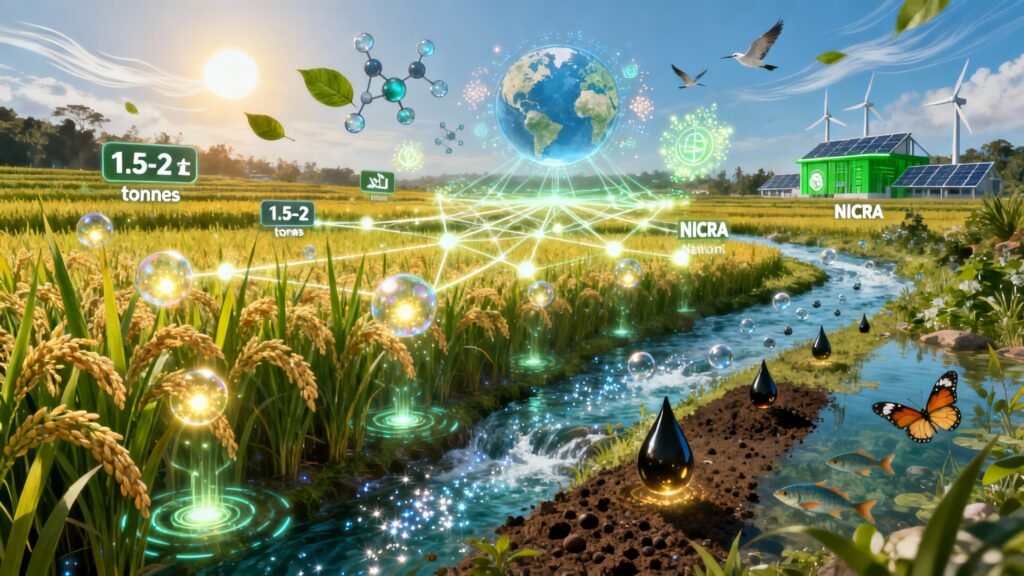
What makes Dry DSR particularly compelling is its eligibility for participation in emerging carbon and sustainability markets. The World Bank’s Carbon Farming Facility and CGIAR’s Climate Change, Agriculture and Food Security (CCAFS) programme are already piloting methodologies in Southeast Asia that quantify and monetise emission reductions from DSR adoption. These pilots use satellite-based methane flux estimation, field-level monitoring, and standardised MRV (Measurement, Reporting, and Verification) frameworks — tools that India can readily adapt through its National Innovations in Climate Resilient Agriculture (NICRA) network and ICAR institutes.
“Our DDSR varieties combine the drought tolerance of upland rice with the high-yield potential of lowland rice. They are developed through conventional plant breeding and molecular techniques to ensure performance and adaptability. This innovation is a result of years of scientific research dedicated to farmers’ needs.”
– Dr. Sowjanya M.S., Manager – Seeds Research, KisanKraft Limited
If integrated properly, Indian farmers could earn carbon-linked incentives of Rs 1,500 – Rs 2,000 per hectare per season, effectively turning climate stewardship into an income source. For cooperatives and Farmer Producer Organisations (FPOs), aggregated carbon projects could open access to voluntary markets where corporates seek credible agricultural offsets. It is, in many ways, the next evolution of the “green revolution” — not one of yield, but of verified climate value.
Beyond the carbon ledger, Dry DSR carries clear sustainability dividends that align with India’s Nationally Determined Contributions (NDCs) and its net-zero by 2070 ambition. By conserving groundwater, reducing energy use, and improving soil organic carbon, DSR contributes simultaneously to mitigation and adaptation goals — a rare dual benefit in climate policy. The Indian Council for Research on International Economic Relations (ICRIER) estimates that if even one-fifth of Punjab’s rice area transitions to DSR, the state could save 2.1 billion cubic metres of water annually and cut methane emissions equivalent to removing nearly one million cars from the road.

The ripple effects extend to trade. As global food buyers increasingly embed sustainability criteria in sourcing contracts, low-carbon rice could soon become a market differentiator. Premium importers in Japan, the European Union, and the United Arab Emirates are already demanding verified “sustainable rice” certified under the Sustainable Rice Platform (SRP) standard. India’s Agricultural and Processed Food Products Export Development Authority (APEDA) is well positioned to seize this opportunity: its blockchain-enabled traceability system can tag DSR rice from seed to shipment, offering importers complete visibility into its environmental footprint.
By branding such produce as “Green Grain from India,” the country could unlock new export niches and enhance its reputation as a responsible agricultural power. The potential goes beyond symbolism — it could translate into tangible price premiums, improved farmer incomes, and stronger negotiating leverage in global agri-trade.
In a world where sustainability has become the new tariff, Dry DSR represents both an ecological imperative and an economic strategy. It reframes India’s rice story from one of resource exhaustion to one of regenerative leadership — where every grain not only feeds the world, but also lightens the planet’s carbon load.
The Road Ahead: From Pilots to Policy Architecture
For Dry DSR to move beyond pilot status, India will need an integrated policy architecture that spans research, incentives, and ecosystem coordination. Experts advocate a National Mission on Direct Seeded Rice, nested within the National Rice Development Programme, to provide consistent policy direction.
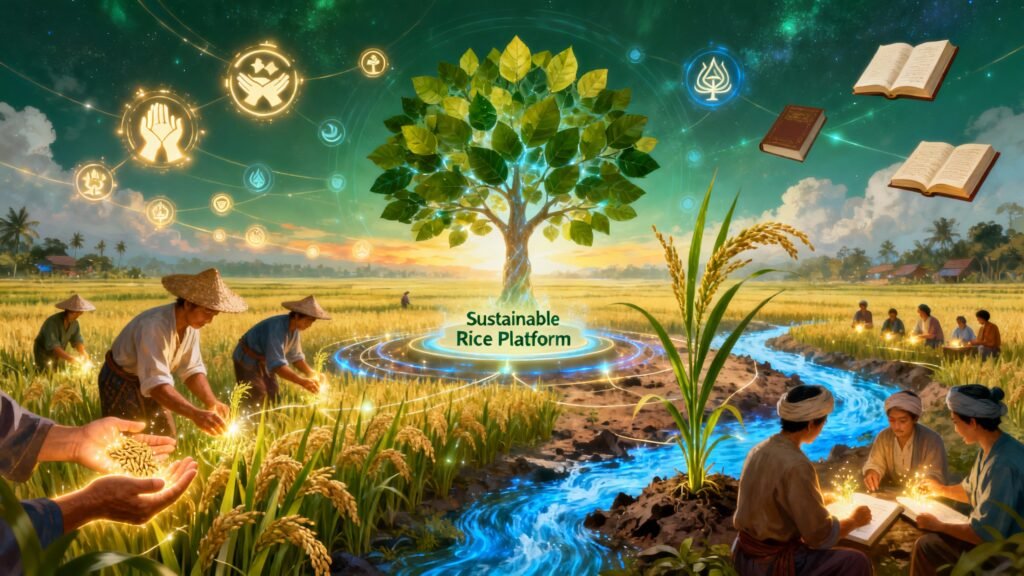
Seed systems are central. Breeding must prioritise short-duration, non-lodging DSR varieties capable of handling variable moisture and mechanical planting. Simultaneously, institutional mechanisms must expand FPO-led service models for shared machinery and input access.
The private sector has a catalytic role. Input firms like Bayer, UPL, and IFFCO are already developing DSR-tailored herbicide packages and microbial soil solutions. Digital agritech platforms can close the last-mile advisory gap, integrating weather data, soil analytics, and real-time irrigation scheduling.
Critically, risk insurance must evolve to account for moisture-related germination failures and yield variability, making adoption financially less risky. Linking DSR adoption with climate finance, CSR portfolios, and green bond frameworks could further amplify its scale.
— Suchetana Choudhury (suchetana.choudhuri@agrospectrumindia.com)